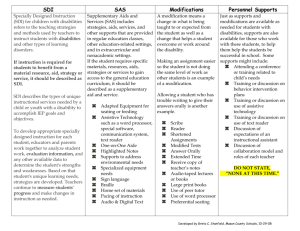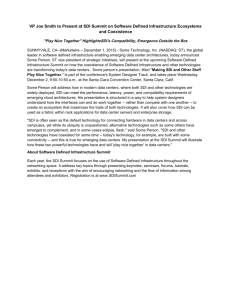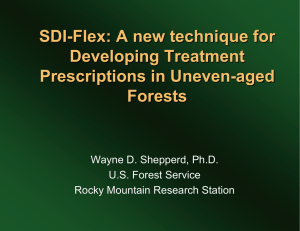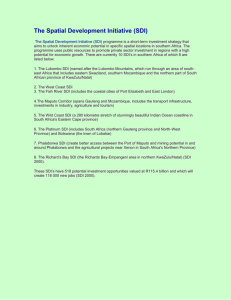SDI-Flex: A New Technique of Allocating Growing Stock for Developing Treatment
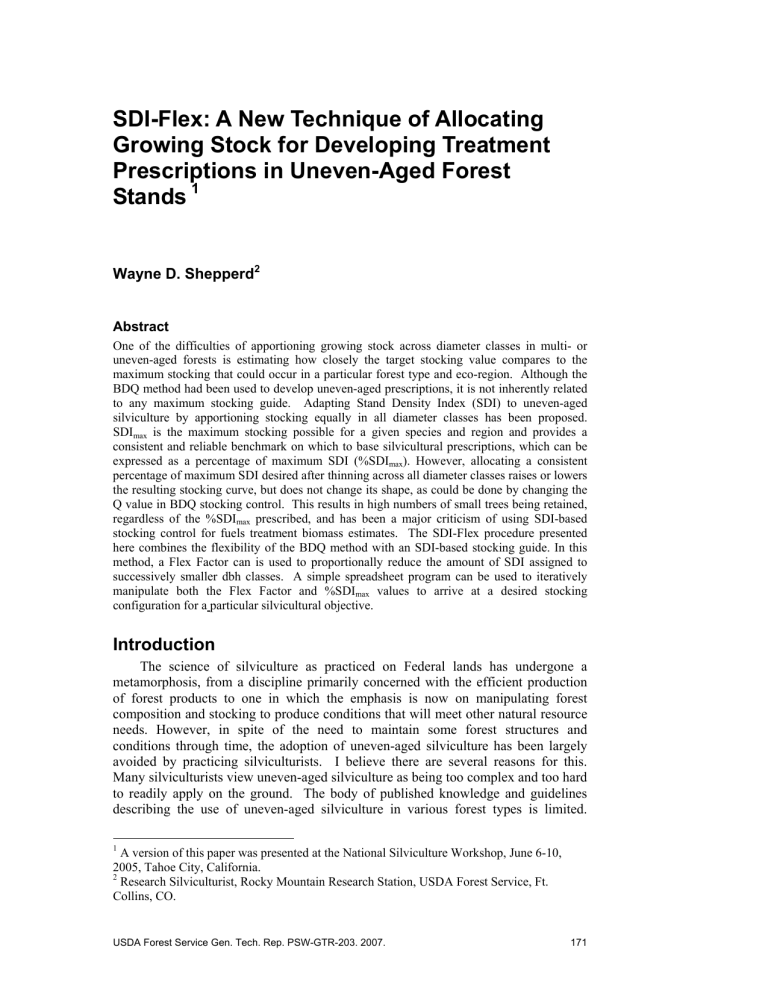
SDI-Flex: A New Technique of Allocating
Growing Stock for Developing Treatment
Prescriptions in Uneven-Aged Forest
Stands
1
Wayne D. Shepperd
2
Abstract
One of the difficulties of apportioning growing stock across diameter classes in multi- or uneven-aged forests is estimating how closely the target stocking value compares to the maximum stocking that could occur in a particular forest type and eco-region. Although the
BDQ method had been used to develop uneven-aged prescriptions, it is not inherently related to any maximum stocking guide. Adapting Stand Density Index (SDI) to uneven-aged silviculture by apportioning stocking equally in all diameter classes has been proposed.
SDI max
is the maximum stocking possible for a given species and region and provides a consistent and reliable benchmark on which to base silvicultural prescriptions, which can be expressed as a percentage of maximum SDI (%SDI max
). However, allocating a consistent percentage of maximum SDI desired after thinning across all diameter classes raises or lowers the resulting stocking curve, but does not change its shape, as could be done by changing the
Q value in BDQ stocking control. This results in high numbers of small trees being retained, regardless of the %SDI max
prescribed, and has been a major criticism of using SDI-based stocking control for fuels treatment biomass estimates. The SDI-Flex procedure presented here combines the flexibility of the BDQ method with an SDI-based stocking guide. In this method, a Flex Factor can is used to proportionally reduce the amount of SDI assigned to successively smaller dbh classes. A simple spreadsheet program can be used to iteratively manipulate both the Flex Factor and %SDI max
values to arrive at a desired stocking configuration for a particular silvicultural objective.
Introduction
The science of silviculture as practiced on Federal lands has undergone a metamorphosis, from a discipline primarily concerned with the efficient production of forest products to one in which the emphasis is now on manipulating forest composition and stocking to produce conditions that will meet other natural resource needs. However, in spite of the need to maintain some forest structures and conditions through time, the adoption of uneven-aged silviculture has been largely avoided by practicing silviculturists. I believe there are several reasons for this.
Many silviculturists view uneven-aged silviculture as being too complex and too hard to readily apply on the ground. The body of published knowledge and guidelines describing the use of uneven-aged silviculture in various forest types is limited.
1 A version of this paper was presented at the National Silviculture Workshop, June 6-10,
2
2005, Tahoe City, California.
Research Silviculturist, Rocky Mountain Research Station, USDA Forest Service, Ft.
Collins, CO.
USDA Forest Service Gen. Tech. Rep. PSW-GTR-203. 2007. 171
Silvicultural Options—SDI-Flex: A New Technique—Shepperd
Specific standards for using BDQ stocking guide curves have not been developed for all forest types. No equivalents to Gingrich curves (Gingrich 1967), stand density management diagrams, or other stocking guides exist for uneven-aged silviculture.
Silviculturists are forced to rely on intuitive measures and personal experience to develop uneven-aged prescriptions and, therefore, may be reluctant to prescribe vegetation treatments that cannot be substantiated by scientific literature. This paper proposes to remedy this situation by introducing a new modification of a longestablished even-aged stocking guide that can be used to develop a wide variety of uneven-aged prescriptions in all forest types.
A Brief Review of Stand Density Index
A thorough and complete discussion of the history of Stand Density Index (SDI) and an evaluation of the various ways of calculating it was presented by Ducey and
Larson (2003) and will not be duplicated here. Basically, SDI was conceived by
Reineke (1933) to describe the empirical relationship between quadratic mean stand diameter (D q
) and tree density in even-aged forests. Reineke noticed that a consistent pattern existed when average tree size and stand density data from numerous stands were plotted on a log/log scale ( fig. 1 ). He chose to express this relationship mathematically as an index equivalent to the number of 10-inch trees that might occur in a forest of a given density and derived the following equation to describe it:
SDI = N(D q
/10) 1.605
Where: N = trees ac -1
And D q
= quadratic mean stand diameter
Since D q
can be other than 10 inches, SDI is really an index most of the time.
The pattern shown in Figure 1 occurred among all species that Reineke investigated, although the height of the data swarm varied by species. The use of a 10-inch size standard in the SDI equation allows the maximum SDI value for a tree species in a locality to be calculated by dividing the maximum stand basal area found in the defined population by the basal area of a 10-inch tree (0.5454 ft 2 ):
SDI max
= (BA max
/0.5454)
For example, if the maximum average stand basal area for a tree species in an eco-region is 270 ft 2 ac -1 , then:
SDI max
= (270/0.5454) = 495
Stocking in any given stand can therefore be expressed as a percentage of
SDI max
. These percentages are roughly equivalent to the percent maximum density lines that appear on Gingrich stocking charts ( fig. 2 ) (I say roughly, because some
Gingrich curves were sometimes re-fit to individual species data using modern nonlinear regression techniques, and were not derived using Reineke’s SDI equation).
However, the similarities are sufficient to provide a direct link between even-aged stocking guides that appear in Forest Service Silviculture handbooks and Reineke’s
SDI.
172 USDA Forest Service Gen. Tech. Rep. PSW-GTR-203. 2007.
Silvicultural Options—SDI-Flex: A New Technique—Shepperd
Figure 1-Quadratic mean stand diameter (Dq) versus tree density (TPA) for ponderosa pine in Colorado, plotted on log normal scales with SDI max
= 450 line (from
FIA data).
300
250
20
18
Quadratic
16 mean diameter (inches)
14
12
10
9
Ponderosa Pine
200
8
7
Average maximum density
6
5
150
100
50
Managem ent zone
30%
90%
80%
70%
60%
50%
40%
4
3
20% Relative stand density
0
0 200 400 600 800 1000 1200
Trees per acre
Figure 2-Gingrich stocking chart for even-aged ponderosa pine in Colorado.
Average maximum density corresponds to SDI max
.
USDA Forest Service Gen. Tech. Rep. PSW-GTR-203. 2007. 173
Silvicultural Options—SDI-Flex: A New Technique—Shepperd
Modifying SDI for Use in Uneven-Aged Silviculture
Long and Daniel (1990) presented a modification of SDI for use in unevenaged stands. They proposed calculating a partial SDI for each diameter class, and then summing the values to obtain an overall stand SDI in the following manner:
SDI = ∑ N i
(D i
/10) 1.605
Where: N
And D i i
= trees ac -1 in diameter class i
= mid-point of diameter class i
This equation can be utilized to proportion desired post-harvest target stocking evenly among diameter classes by calculating a target stocking density for each diameter class (D i
) in the stand. First, a target SDI (SDI t
) is calculated by dividing the percentage of maximum SDI desired for the residual stand by the number of dbh classes in the stand. SDI t for N i
. giving: is then substituted for SDI in the above equation and solved
N i
= SDI t
/(D i
/10) 1.605
This procedure results in tree ac -1 stocking values across diameter classes that typify the “reverse J” target stocking curve associated with uneven-aged forests. In this case, each dbh class contains an equal proportion of the overall desired percentage of maximum SDI for the stand. While this procedure allows the overall target stocking to be adjusted to any percent of maximum SDI, the even apportionment of SDI over all diameter classes does not provide the ability to adjust the slope of the resulting stocking curve, as could be done by changing the Q value in
BDQ stocking control. The result is a high number of small trees being retained regardless of the percentage of maximum SDI prescribed. This shortcoming hinders the flexibility and usefulness of the Long and Daniel approach, especially when open understories are needed (e.g. prescribing uneven-aged treatments to reduce crownfire risk).
The SDI-FLEX Procedure
This paper presents an alternative method of calculating a target stocking distribution for uneven-aged forest stands that allows the shape of the SDI target stocking curve to be changed, as well as its height ( fig. 3 ), and permits the development of an infinite variety of uneven-aged stocking curves. This is accomplished by utilizing a “Flex Factor” to systematically reduce the portion of SDI assigned to smaller dbh classes. Stocking can then be adjusted to alter stand characteristics to meet multiple resource needs, while still meeting the percentage of maximum SDI stocking desired for the stand. For example, denser understories can be provided to stimulate the development of good tree form, provide hiding cover, or discourage the development of undesirable shrubs. Or, conversely, sparse, open understories can be created to favor forage growth, or reduce live ladder fuels where crownfire risk is a concern. Figure 4 illustrates the dramatic effect that flexing SDI can have on the appearance of a forest stand. The only limitation that should be placed on the development of uneven-aged stocking curves using this technique is that sufficient numbers of trees should be retained in smaller diameter classes to grow
174 USDA Forest Service Gen. Tech. Rep. PSW-GTR-203. 2007.
Silvicultural Options—SDI-Flex: A New Technique—Shepperd into and replace trees in larger classes (e.g. the stocking curve should always slope slightly downward to the right to retain the “reverse J” shape).
300
250
200
150
100
Flex=1
Flex=0.9
Flex=0.8
50
0
2 4 6 8 10 12 14 16 18 20 22
DBH
Figure 3-Flexing the distribution of SDI allows both the height and shape of a desired stocking curve to be changed (Note that the %SDI max
is not the same under these three curves).
Figure 4– The stand at the top was thinned to 20% SDI max
using an even apportionment of SDI to all diameter classes (center) and a Flexed apportionment that kept overall stocking at 20% SDI max
, but reduced stocking in smaller diameter classes (lower). Graphs were produced using Stand Visualization System (SVS) software (McGaughey 1997).
USDA Forest Service Gen. Tech. Rep. PSW-GTR-203. 2007. 175
Silvicultural Options—SDI-Flex: A New Technique—Shepperd
SDI-FLEX Calculations
An example of a spreadsheet that can be constructed to develop prescriptions using the SDI-Flex approach is shown in table 1 . Dbh class midpoints are listed in
Column A. Trees per acre (TPA) stocking values obtained from inventory data for each dbh class are listed in Column B. The user must also specify the maximum SDI value used for the forest type and locality and enter the number of dbh classes that contain trees in appropriate cells. Basal areas are calculated in Column C using the following formula:
BA i
= TPA i
*(dbh i
2 * 0.0054542)
SDI values for each diameter class in the existing stand are calculated in
Column D, using the formula given earlier. Succeeding columns are used to develop a prescription and marking guide to treat the stand by first calculating a desired target stocking curve, using user supplied values for SDI max
and two control parameters called the Seed and Flex factor, which control the percentage of SDI max
under the target stocking curve and the shape of the curve. This is done by placing a “1” in the largest dbh class desired for the stand, and sequentially reducing that value by the
Flex Factor listed at the bottom of Column E in cells above for each successively smaller dbh class (e.g. FLEX
20
= 0.9 * 1, FLEX
18
= 0.9 * 0.9, FLEX
16
= 0.81 * 0.9, etc.). Target SDI values in Column F are calculated using the following formula:
Target SDI i
= (SDI max
/No. dbh classes * SDI Seed) * FLEX i
(Note: the number of dbh classes specified should be either the number of stocked dbh classes, or the number of dbh class desired for the managed stand.)
The SDI Seed parameter is used to adjust stocking uniformly over all dbh classes to adjust the stocking to a desired percentage of maximum SDI. The values in
Column F represent the desired stocking in each dbh class following the geometric stocking curve specified by the Flex Factor, which sequentially reduces the portion of
SDI in each successively smaller dbh class. Setting the Flex Factor to 1.0 results in an even apportionment of SDI over all dbh classes, as with the Long and Daniel (1990) procedure. Using a value less than 1.0 flattens the stocking curve, reducing the number of trees in smaller dbh classes. Target TPA values for each diameter class are calculated in Column G by substituting each SDI i earlier:
value into the formula presented
TPA i
= SDI i
/(D i
/10) 1.605
Setting the SDI Seed to a desired percentage of SDI max
will result in an actual percent SDI stocking target that is less than the desired value, since the portion of
SDI assigned to smaller db classes is sequentially reduced. Therefore, both the Flex
Factor and SDI Seed values must be iteratively manipulated until the desired actual
%SDI max
is obtained. The smaller the Flex Factor, the larger SDI Seed must be to achieve the desired actual %SDI
Factor of 1.0 and the %SDI max max
. In practice, the user should first specify a Flex
as the SDI Seed, then iteratively decrease the Flex
Factor until stocking in smaller diameter classes is reasonable, and finally raise the specified SDI Seed until the actual %SDI residual stand. max
approaches the desired level for the
176 USDA Forest Service Gen. Tech. Rep. PSW-GTR-203. 2007.
Silvicultural Options—SDI-Flex: A New Technique—Shepperd
Since these calculations derive a theoretical desired stocking curve, they have to be adjusted to reflect actual stocking if any dbh classes are unoccupied, or are stocked at less than desired target values. This is accomplished using a MIN spreadsheet function in Column I to choose the minimum of either the target
(Column G), or existing (Column B) stocking and subtracting that value from the existing stocking to calculate the number of trees to be cut.
Residual TPA, BA, and SDI values after the harvest are calculated in Columns J,
K, and L, respectively. The actual residual %SDI max
left after harvest is shown at the bottom of Column L. If local stem volume conversion factors are available the spreadsheet can be further modified to calculate per acre volume yields by multiplying the cut TPA values for each diameter class by the associated conversion factor and summing the results.
To help develop marking guides for the prescription, cuts for each dbh class are also expressed in Column M as a proportion of original stocking. For example, a cut proportion of 0.8 would mean to mark eight out of every 10 trees encountered in that dbh class. Per acre summaries of all columns and %SDI max
values are displayed for existing, target, and residual stand conditions to aid the user in evaluating prescription alternatives and allow the user to see the relationship between tree density, basal area, and SDI for a given prescription. The user may also desire to set up a spreadsheet graph that plots actual, target, and residual stocking across dbh classes to aid in prescription development.
Discussion
This procedure provides an easy-to-use and highly effective means of developing uneven-aged silviculture prescriptions that are based on a long-accepted empirically-derived stocking guide that is unique to each tree species. Residual stocking can be adjusted to meet a variety of silviculture needs, while retaining an expectation of the forests potential for future production and growth.
The SDI-flex approach must be applied with an eye toward achieving the desired residual stand condition configured in a way that meets the diverse structural attributes in the stand. The best approach is for the user to decide in advance what the target residual basal area and residual SDI should be. Then, adjustments in flex and seed should be made iteratively until those target attributes are attained. It’s tempting to merely look at the volume to be removed and work the program until a desired volume target is obtained, and this may be valuable to help decide whether a proposed treatment will be commercially operable. But future growth of the stand depends on retaining acceptable basal area after the harvest, distributed in the proper diameter classes to meet the structural needs of the stand. Most growth models show that volume increment is highly correlative with the starting basal area. Future growth in stands managed using the SDI-flex will depend upon retaining acceptable residual basal area and %SDI max
after the proposed cut. There are no safeguards other than user attentiveness to be certain that the seed and flex variables are properly applied, and result in an appropriate residual stand condition. But if these cautions are observed, the model is a very quick and creative way to configure SDI among diameter classes toward the goal of meeting the desired structural goal.
The actual percentage of maximum SDI retained after harvest is roughly equivalent to the percent of maximum stocking lines shown on even-aged Gingrich stocking curves and can serve a similar purpose in guiding management. As in even-
178 USDA Forest Service Gen. Tech. Rep. PSW-GTR-203. 2007.
Silvicultural Options—SDI-Flex: A New Technique—Shepperd aged silviculture, trade-offs exist between optimizing the productive capabilities of a site and meeting alternate resource demands for the forest. For example, a forest stocked at levels above 50% maximum SDI is likely to be subject to densitydependent mortality and be susceptible to insect attack (Oliver 1995). Conversely, a forest stocked at 15–20% maximum SDI is probably stocked at less than full occupancy, is not producing optimal yields, and may contain open-grown trees that are limby and of poor form.
Several observations have become apparent from using the SDI-Flex procedure that should be mentioned here. Initial users have had questions as to what maximum
SDI value to use for mixed species stands. I suggest using a maximum SDI associated with the tree species that is most likely to regenerate, or alternatively, using the max SDI value for the most intolerant species for which regeneration is sought. If attempting to restore a ponderosa pine forest from a mixed conifer condition, I recommend using the maximum SDI for ponderosa pine to produce favorable conditions for regeneration and growth of that species. Higher residual stocking levels will tend to favor regeneration of shade tolerant species while lower stocking will favor intolerant species. Similarly, “Steep” stocking curves with numerous small trees in the understory will favor shade tolerant species, while
“shallow” curves will favor intolerant species. Low SDI values in residual stands will generally encourage abundant natural regeneration, as well as development of associated understory species. This could be desirable in vegetation associations that provide forage to wildlife or livestock, or undesirable if the understory consists of aggressive shrubby species.
When developing prescriptions for reducing crownfire risk, even a few lowcrowned residual trees will affect average crown height and thus result in a low torching index. Adverse effects can be avoided in these cases by managing for grouped or clumped regeneration, or marking the stand to isolate low-crowned trees from larger trees. Even so, managers must accept that partial tree removal alone cannot change fire behavior in all cases and may result in abundant regeneration, regardless of whether even- or uneven-aged silviculture is used. Mechanical pruning or prescribed burning under safe conditions may be needed to raise crown base heights and reduce torching potential.
One reviewer suggested using the “Solver” spreadsheet function to automatically do the iterative calculations to find the SDI Flex and Seed factors that would yield the %SDI max
desired for the stand. While that is certainly possible to do, the intent here is to give the user maximum flexibility to seek a stocking configuration that will meet the overall management objectives for the stand.
Controlling the iterative process manually allows the user to examine alternative approaches to developing a prescription, and to weigh the trade-offs between yields and residual stocking across all diameter classes. Hopefully, this approach will help achieve a workable compromise among sometimes conflicting management goals.
In conclusion, I believe that using the SDI-Flex procedure provides silviculturists a quick and easy method of evaluating uneven-aged silviculture prescription alternatives. The procedure uses a well-established scientifically-based, stocking guideline familiar to even-aged silviculture practitioners that can be adjusted to specific tree species and local growing conditions. The spreadsheet example presented here allows easy calculation of existing, target, and residual stocking and easy manipulation of parameters to develop a wide variety of uneven-aged
USDA Forest Service Gen. Tech. Rep. PSW-GTR-203. 2007. 179
Silvicultural Options—SDI-Flex: A New Technique—Shepperd prescriptions for today’s diverse forest management needs. Example SDI-Flex spreadsheets are at: http://www.fs.fed.us/rm/landscapes/Solutions/SDI_Flex.shtml
References
Ducey, M.J.; Larson, B.C. 2003. Is there a correct Stand Density Index?
An Alternate
Interpretation. Western Journal of Applied Forestry 18(3): 179-184.
Gingrich, S. F. 1967. Measuring and evaluating stocking and stand density in upland hardwood forests in the Central States.
Forest Science 13:38-53.
Long, J.N.; Daniel, T.W. 1990. Assessment of growing stock in uneven-aged stands.
Western Journal of Applied Forestry 5(3): 93-96.
McGaughey, R.J. 1997. Visualizing forest stand dynamics using the stand visualization system.
In: Proceedings of the 1997 ACSM/ASPRS Annual Convention and
Exposition; April 7-10, 1997. Bethesda, MD: American Society for Photogrammetry and Remote Sensing. 4: 248-257.
Oliver, W.W. 1995. Is self-thinning in ponderosa pine ruled by Dendroctonus bark beetles?
In: Eskew, L.G., compiler. Forest health through silviculture. Proceedings of the 1995 National Silviculture Workshop, May 8-11; Mescalero, NM. Gen. Tech. Rep.
RM-GTR-267. Fort Collins, CO: U.S. Department of Agriculture, Forest Service,
Rocky mountain Forest and Range Experiment Station. 213-218.
Reineke, L.H. 1933. Perfecting a stand-density index for even-aged forests.
Journal of
Agriculture Research. 46:627-638
180 USDA Forest Service Gen. Tech. Rep. PSW-GTR-203. 2007.
